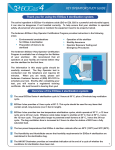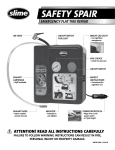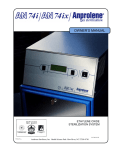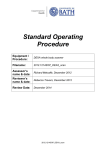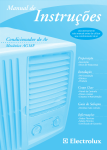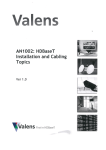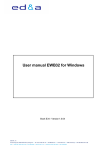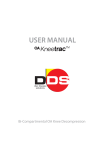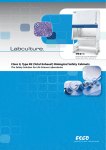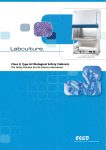Download key operator study guide
Transcript
4 KEY OPERATOR STUDY GUIDE Thank you for using the EOGas 4 sterilization system. The active ingredient in EOGas 4 is ethylene oxide (EtO or EO). EtO is a powerful anti-microbial agent; it can also be dangerous if not handled correctly. To help ensure that your sterilizer is operated safely, all personnel who operate or maintain the equipment need to be properly trained. The Andersen EOGas 4 Key Operator Certification Program provides instruction in the following areas: Environmental considerations for EOGas 4 sterilization Preparation of items to be sterilized The Andersen EOGas 4 Key Operator Certification Program is available free of charge for the lifetime of your sterilizer. We recommend that all operators at your facility are trained before they use the sterilizer for the first time. Operation of the sterilizer Sterility Assurance Operator Exposure Testing and Emergency Procedures 4 EOGAS 4 STERILZER S T E R I L I Z E R The information in this study guide should be carefully reviewed. The Key Operator test is conducted over the telephone and requires 20 minutes. When you are ready, please call Andersen Customer Service at 01255 428 328 to schedule your test. Shortly after completing your test, you will receive a registered training certificate. We look forward to hearing from you! Overview of the EOGas 4 sterilization system. 1 The usual EOGas Series 4 sterilization cycle is 3 hours at 50° C, plus a 30-minute bag ventilation cycle. 2 EOGas 4 also provides a 5 hour cycle at 50° C. This cycle should be used for any items that contain small, long lumens (over 3 feet in length). 3 EOGas 4 also provides two low temperature sterilization cycles, which operate at 30° C., a 12 hour cycle and a 24 hour cycle. Ethylene oxide takes longer to sterilize at 30° C. than at 50° C., hence the 12 hour cycle. The gas takes longer to penetrate small lumens at 30° C., hence the 24 hour cycle. The bag ventilation time is increased to 2 hours to allow for elution of EtO from a fully saturated load. 4 The two preset temperatures that EOGas 4 sterilizer cabinets offer are 50ºC (122ºF) and 30ºC (86ºF). 5 The Humidichip and Humiditube ensure that humidity requirements for EOGas 4 sterilization are maintained in the sterilization bag. 6 The AN1087 Dosimeter provides an immediate indication at the end of a cycle of whether the conditions for sterilization have been met. 1 4 KEY OPERATOR STUDY GUIDE Environmental Considerations 1 91º F 68º F Temperature Store your EOGas 4 gas refill kits in a cool, secure area. We recommend storage below 70°F. The sterilizer must be used in an area where the temperature is not less than 68°F or more than 91°F . This temperature range must be maintained during the entire sterilization cycle. EtO FACTS: At sea level, ethylene oxide is a liquid below 51°F. Above 51°F, EtO begins to boil and converts into a gas. EtO does not become an effective sterilant until 68°F. Even though the EOGas 4 cabinet is heated make sure that the room where your EOGas sterilizer is installed remains above 68°F. 2 35% Humidity Humidity is very important to the EOGas process. Relative Humidity (RH) must be at least 35% in the room where item preparation and sterilization take place. Spores that might be on the instruments may become desiccated and resistant to EOGas if the RH is below 35%. The simplest way to humidify items is to wash them. It is necessary to humidify items which cannot be washed by enclosing them in a plastic bag with an Andersen Humidichip® or a damp sponge for four hours prior to sterilization. Preparing the items for sterilization Four basic preparation steps must always be followed: 1 Disassemble Items containing removable parts such as syringes must be taken apart before washing, drying, and wrapping them to allow the EOGas an unobstructed path. WARNING: Instruments which contain batteries should be taken apart and the batteries removed and wrapped separately to protect against a spark occurring and igniting the ethylene oxide gas. 2 2 Wash Items must be washed surgically clean prior to sterilization using detergent and water. 4 3 KEY OPERATOR STUDY GUIDE Dry Two accepted ways to dry any item prior to sterilization with EOGas are: 1. Towel drying 2. Drain drying (air drying) WARNING: Heat or hot air should never be used to dry an item prior to sterilizing it with EOGas because it will dehydrate or desiccate bacteria spores making them more resistant to the ethylene oxide gas. WARNING: Any water left on items may react with ethylene oxide. Please air dry instruments thoroughly. 4.2 4 AN86 Wrap The following types of wrapping material are recommended for use with EOGas 4: 1. Andersen Seal and Peel® Packaging (which is airtight and waterproof and greatly extends the shelf life when heat sealed at both ends). 2. Cloth, like CSR wrap, has an estimated sterile shelf life of 30 days. 3. Paper / plastic and Tyvek® / plastic pouches - follow manufacturer's guidelines for shelf life. HINT: Exposure indicators such as the Andersen AN85 or AN86 are used to seal or label items. Indicators will change color in the presence of EtO, helping to later identify items that have be sterilized. Exposure indicators DO NOT indicate sterility. Selecting Cycle Length The EOGas 4 sterilizer offers four different sterilization cycles. ACTIVATE CARTRIDGE CLOSE DOOR SELECT CYCLE LENGTH 5 HOUR 3 HOUR 50º C – 3 Hour sterilization exposure, 30 minute bag ventilation 50º C – 5 Hour sterilization exposure, 60 minute bag ventilation 30º C – 12 Hour sterilization exposure, 120 minute bag ventilation 30º C – 24 Hour sterilization exposure, 120 minute bag ventilation The same sterilization liner bag and cartridge is used for each of the different sterilization cycles that are available. For most items, the 3 HOUR cycle will be adequate. When sterilizing lengths of tubing greater than 90 cm (3 feet) with lumens smaller than 1 mm, or loads containing large amounts of gas absorbent materials, the extended length, 5 HOUR cycle must be used. 3 4 KEY OPERATOR STUDY GUIDE For temperature sensitive items, use the 12 or 24 hour room temperature mode. Starting the Cycle The EOGas 4 sterilization cycle is described here in correct sequence for items that have been disassembled, washed, dried, and wrapped. 1 Prior to loading the sterilizer, turn the power on by pressing the black power switch located on the back of the sterilizer. The initial screen will appear. EOGAS 4 STERILIZER SETUP 22.0ºC START or ROOM TEMPERATURE STERILIZATION MODE SETUP 22.0ºC START EOGAS 4 STERILIZER START 2 Press the button to the right of START on the display screen to initiate the self test. 3 When the warm up screen appears you can exit or await temperature reading of 48.0ºC: SELF TEST OK 0 PUMP HOURS EOGAS 4 WARMUP EXIT 4 31.0ºC After the sterilizer reaches 48.0ºC, loading instructions are shown on the screen. LOAD EOGAS LINER BAG CLOSE BAG OVER TUBE PURGE BAG EXIT 48.0ºC PURGE 5 Open the sterilizer door, remove a new sterilization liner bag from the AN1004 Refill Kit, and place it inside the sterilizer cabinet with the open end facing out. 6 Use only an EOGas 4 sterilization liner bag, and always use a new liner bag for each sterilization cycle. 7 Place the wrapped items for sterilization inside the sterilization liner bag. 5 7 4 4 9 KEY OPERATOR STUDY GUIDE 8 Place a Dosimeter and Humiditube with a Humidichip inside the EOGas sterilization bag. (See picture on page 7.) 9 Insert a biological control (optional but recommended). 10 Remove one AN1004 EOGas cartridge from the Refill Kit. Remove the trigger safety guard. 10 11 Place it in the liner bag on top of the wrapped items so it can easily be manipulated through the wall of the bag after the sterilization liner bag has been closed. Do not activate the cartridge at this time. 12 Insert the purge probe into the sterilization liner bag with the plastic ball towards the bottom of the bag and the bobbin towards the opening. 11 13 Gather the open end of the sterilization liner bag around the bobbin of the purge tube, taking care to leave no openings. 12 14 Wrap the black Velcro® strap around the outside of the sterilization liner bag and thread the pointed end of the strap through the square black loop. Pull the Velcro strap firmly and cinch it back around the exposed Velcro surface of the strap. VERY IMPORTANT: Make sure that the Velcro strap is secure and provides a sound closure between the bobbin of the purge tube and the sterilization liner bag with no folds outside of the strap. QUICK CONNECT BOBBIN If the purge tube has been disconnected from the sterilizer by means of the quick release connector, re-attach it by pressing the male and female ends together. Bobbin 13 TIP: Disconnecting the purge tube is a convenient way to load and close the sterilization bag away from the sterilizer cabinet. Initial Purge With the cabinet door still open, press the PURGE button. INITIAL PURGE 00:01:29 REMAINING EXIT 50.0ºC The sterilizer will purge air out of the sterilization liner bag for one minute, 30 seconds. The display will read INITIAL PURGE and will countdown to 00:00:00. 5 4 KEY OPERATOR STUDY GUIDE After the initial purge has been completed the display instructs the Operator to: ACTIVATE CARTRIDGE CLOSE DOOR SELECT CYCLE LENGTH 5 HOUR 3 HOUR or ACTIVATE CARTRIDGE CLOSE DOOR SELECT CYCLE LENGTH 24 HOUR 12 HOUR Sterilization 1 Activate the cartridge by pressing the button on the cartridge through the wall of the closed sterilization liner bag. 2 Close the door and, 3 Select the length of the sterilization cycle. (3 or 5 hours) or (12 or 24 hours). The door will lock automatically. 4 For most items, the 3 HOUR cycle will be adequate. If a cycle time is not selected within 5 seconds of taking the third step (above), a continuous alarm will sound to remind you to choose a cycle length. 3 HOUR CYCLE STERILIZING 2:59:15 REMAINING 50.0ºC The display counts down from the cycle time selected and the door remains locked. Ventilating Cycle At the end of the sterilization cycle, the cabinet ventilation pump and the purge pump will run in 2 minute intervals, purging the liner bag and ventilating the cabinet. This alternating cycling of the purge and cabinet ventilation continues for 30 minutes for the 3 hour cycle, 1 hour for the 5 hour cycle, and 2 hours for the 12 or 24 hour cycle. The display counts down time until it reaches 00:00:00. VENTILATING BAG 00:23:55 REMAINING 50.0ºC 6 4 KEY OPERATOR STUDY GUIDE At the end of the ventilating cycle the screen will display: UNLOAD STERILIZER 00:03:11 EXIT 50.0ºC The time display now indicates time elapsed since the cycle end. Unloading 1 Opening the door stops the count up timer. 2 The ventilation and purge pumps will continue to run until the door is closed and the Exit option is selected. A count up timer will keep track of additional aeration time. 3 Exit returns the Start Screen. 1 To unload the sterilizer, open the door and release the velcro strap from the purge probe. Keep the purge probe and Velcro strap in place if gas absorbent items in the load require further aeration. Unload the sterilization bag in the aeration area, or in an aeration chamber. 2 Check the Dosimeter for a color change from yellow to blue up to the triangular mark on it’s pink holder to verify the dose of gas in the bag. 3 If a biological indicator was used, begin culturing BI according to manufacturer's instructions. 4 The items may now be removed from the AN1004 sterilization bag. Discard the sterilization bag, Humidichip and empty cartridge in ordinary rubbish, or in accordance with local regulations. 5 The Humiditube is reusable. Do not discard. TM AN1071 AN1072 7 4 Sterility Assurance KEY OPERATOR STUDY GUIDE 1 Biological Indicators (BI's) such as the Steritest reliably verify that sufficient concentration of EtO killed one million B. Atrophaeus spores. After incubation, color change from bluegreen to yellow would distinctly indicate a positive culture. 2 Chemical Exposure Integrators, such as the Dosimeter provide immediate visual confirmation that time, temperature, and EtO concentration were sufficient for sterilization to occur. 3 Chemical Exposure Indicators, such as the AN85 or AN86, do not prove sterilization. They only change color to show that the items have been exposed to ethylene oxide. Please refer to the manufacturer's instructions provided with any indicator for more information. Safety Precautions B MONITORING SYSTEM 1 The sterilizer has cabinet and bag ventilation pumps that run at appropriate times during the sterilization cycle to prevent personnel from being exposed to more than the OSHA permitted amount. 2 Personnel exposure to ethylene oxide can be monitored by using personal exposure badges, such as the Andersen AN93 AirScan® Badge Kits with both STEL (15 min.) and TWA (8 hour) badges. EtO exposure levels should be checked upon installation of the sterilizer. We recommend that exposure testing be performed on an annual basis or whenever a sterilizer is relocated. 3 Do not allow open flame or sparks near the sterilizer during the sterilization cycle. Ethylene oxide gas is highly flammable in concentrations above 3.0% (30,000 ppm). 1 Two items that do not require aeration are metal and glass. Items made of these materials do not absorb EO. 2 Large, gas absorbing items, especially implants and devices that will contact blood or living tissue may require additional aeration time. A Important Considerations Things that CANNOT be sterilized with EOGas 4: Liquids, food, and drugs should not be sterilized in ethylene oxide because it may change their chemical composition in unpredictable ways. 8 4 3 KEY OPERATOR STUDY GUIDE Two reasons for never activating the EOGas 4 cartridge outside a properly prepared EOGas bag that has been placed in the EOGas 4 sterilizer are: - To prevent the exposure to EtO in excess of OSHA's regulations. To assure the full amount of EtO is available for sterilization. 5 The EOGas 4 cartridge contains the precise amount of EtO needed to sterilize the contents of the EOGas 4 sterilization bag. 6 Two consequences of opening the EOGas bag before the cycle is complete are: - 7 The load might not be sterile. The sterilization bag might still contain high levels of EtO and therefore expose the operator to unacceptable levels of EtO. Power Failures If a power outage occurs during any part of the cycle, the sterilizer is equipped with a battery back up to the circuit board that will keep track of elapsed cycle time. When power is restored, the cycle will continue. Do not open the door of the sterilizer until power is restored and the vent/purge systems have removed any residual gas from the liner bags. HINT: In the case of any sterilizer malfunction or power failure, you can determine whether sterilization was achieved by examining the sterility indicators (biological indicator, Steritest with Dosimeter) included in the load. 9 4 KEY OPERATOR STUDY GUIDE Emergency Procedures 1 If liquid EtO comes into contact with a part of the body you must wash with water thoroughly for at least 15 minutes. 2 The User’s Manual describes, in Section 1, an “Accidental Ethylene Oxide Release Measure”. The Zip-Lock Safety Bag mentioned in this procedure should be kept near the EOGas Series 4 Sterilizer and gas refills. Please refer to Operator's Manual for more information on this procedure. 3 If an EOGas cartridge is accidentally activated, it is very important to get it properly enclosed in an Andersen Zip-Lock Safety Bag quickly. 4 The Material Safety Data Sheet (MSDS) for EOGas should be readily available. Do you know where to find your MSDS? In case of emergency, please contact Chemtel at 800-255-3924. Finally, make a list of any questions that you have about the EOGas system. Your Andersen Representative will be happy to assist you! Here is what you should know after reading this study guide: The minimum temperature needed in the room for the entire sterilization cycle The length (in time) of the standard cycle Why the ventilation system is running during the entire cycle Why the sterilization liner bag is purged The desired relative humidity in the room where the items are prepared How to prepare items for sterilization The types of indicators that are used in the EOGas system Ethylene oxide safety and precautions Basic operation of your EOGas sterilizer from start to finish Operater training records should be maintained at your facility. Key Operator Tests will be kept on file at Andersen Products. 10 the future of gas sterilization PN1125_040909 When you feel comfortable with answers to these subjects, please give Andersen Products a call at 01255 428 328 and schedule your Key Operator Certification exam. The test will take approximately 20 minutes.










